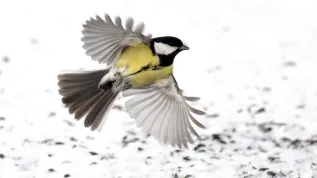
Pollinators that visit infected flowers contribute to spreading pathogens. This phenomenon has been investigated by scientists from the Institute of Nature Conservation of the Polish Academy of Sciences.
The spread of dangerous invasive plant diseases by pollinating insects can lead to significant economic and ecological losses. Knowledge on this subject is therefore important from the point of view of both biodiversity and agriculture.
Researchers from the Institute of Nature Conservation of the Polish Academy of Sciences have identified fungi inhabiting the flowers of one of the most nectar-producing plants in Europe - the invasive Himalayan balsam (Impatiens glandulifera). Its pollinators are primarily two species of bumblebees: Bombus pascuorum and Bombus hortorum. Since it is known that the detected fungi cause dangerous diseases of many other plant species, including cultivated plants, their spread is of great importance not only for Polish nature, but also for domestic agricultural production. The scientists described their observations in the journal NeoBiota.
As part of the study, the biologists identified the factors that influence the presence of pathogen species and the abundance of pollinators. These included the size of the plant, the length of the lower petal of the flower and the width of its inlet, air temperature and insolation. The research was conducted in three Polish regions - the Izera Foothills, Kraków and Muszyna.
Originating from the Himalayas, the Himalayan balsam came to Europe in the 19th century, becoming a very problematic invasive species. Its rapid growth contributes to a significant (up to 25%) reduction in biodiversity in the areas where it has spread. Currently, it grows in 35 countries of our continent, as well as many places in North America, Oceania and Asia. Due to the intense attraction of pollinators, the plant also limits the availability of pollinating insects to wild and cultivated plants naturally occurring in these areas.
Unfortunately, combating this species is very difficult, often impossible. Its growth rate and photosynthesis efficiency are much higher than those of native plants. It also has impressive antimicrobial properties and an interesting ability to spread along watercourses. However, because it is an annual plant that spreads only by seed and has a low ability to self-pollinate, scientists have hopes for the fact that it depends on pollinators. If its attractiveness for this group of animals could be limited, its expansion would be hindered.
For now, the Himalayan balsam plants have mastered attracting pollinators. They produce unprecedented amounts of nectar, amounting to 0.3 mg per hour per flower. Researchers from the Institute of Nature Conservation PAS decided to check whether there were any factors that would affect the activity of this process, with particular emphasis on pathogens found in the Himalayan balsam flowers.
The research was conducted on warm and rainless days. At the same time of day, the number of pollinators visiting the flowers of the selected 10 plants over the course of 60 minutes was counted. At the end of each session, the flowers were cut off, then subjected to anatomical analysis and sent to the laboratory of the Department of Systematic and Environmental Botany of the Adam Mickiewicz University in Poznań.
Previous research has suggested that often, plants infected with fungi (and other pathogens) may be less attractive to pollinators, because the latter can recognize infected flowers and deliberately avoid them. Unfortunately, such plants try to compensate for the presence of pathogens by producing more flowers and/or more nectar, so pathogens found in such frequently pollinated I. glandulifera flowers may ultimately have a better chance of being transferred to other plants visited by the same insects. This applies to both intra-species and inter-species transmission.
In this case, the researchers have determined that the Himalayan balsam is most often visited by two species of bumblebees, regardless of the region of observations. They were B. hortorum and B. pascuorum. The most dangerous and easily spread pathogens by these pollinators were the fungi: Botrytis cinerea (grey mould) and Fusarium graminearum.
'These two fungal pathogens cause devastating diseases of native plant species and hundreds of crop species worldwide and are included in the list of top 10 fungal pathogens in molecular plant pathology (...). Therefore, facilitation of their transmission by I. glandulifera invasion decreases crop production and increases economic losses. Unfortunately, this aspect of harmful impact of alien plant species, as I. glandulifera, is neglected', write the authors of the publication.
In their opinion, this is a big oversight, because biological invasions may have critical consequences for human economy. Although the European Union has tightened the law on the possibility of spread and new introductions of the worst alien species, the level of control of the most invasive alien species is still insufficient.
PAP - Science in Poland, Katarzyna Czechowicz
kap/ bar/













